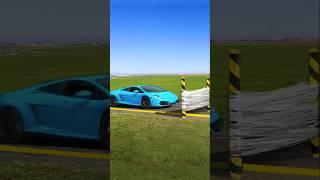![Смотреть 2024 Jaguar I-Pace EV400 HSE in Fuji White | Interior and Exterior Review [4K] HDR 2024 Jaguar I-Pace EV400 HSE in Fuji White | Interior and Exterior Review [4K] HDR](https://hdtube.cc/img/full/OHFNeDlIUjVVRDA.jpg)
2024 Jaguar I-Pace EV400 HSE in Fuji White | Interior and Exterior Review [4K] HDR
The Jaguar I-Pace (stylised as I-PACE) is a battery-electric crossover SUV produced by Jaguar Land Rover (JLR) under their Jaguar marque. The I-Pace was announced in March 2018, European deliveries began in June 2018 and North American deliveries started in October 2018.
The Jaguar I-Pace was designed by Ian Callum.[1] The concept version of the car, described as a five-seater sports car, was unveiled by JLR at the 2016 Los Angeles Motor Show and shown on-road in London in March 2017.[2][3]
The I-Pace is built by contract manufacturer Magna Steyr in Graz, Austria,[4][5] and the production version of the I-Pace was revealed in Graz on 1 March 2018.[6]
Some of the electric drive technology[which?] has come out of the Jaguar I-Type electric Formula E racing car programme,[7] and the concentric motors were developed by JLR engineer Dr. Alex Michaelides.
The Jaguar I-Pace launched with a WLTP-rated range of 292 miles (470 km)[9] and an EPA-rated range of 234 miles (377 km). In December 2019, software enhancements were released to increase range to an EPA-rated range of 246 miles (396 km).[10][11] The car has a wade depth[clarification needed] of 500 mm (20 in).[12] The rear boot holds 656 litres (23 cu ft),[13] along with 28 litres (1 cu ft) of front boot space. The drag coefficient is 0.29.[1]
The car has all-wheel drive via two motors powered by a 90 kWh LG Chem[1] lithium-ion battery with a battery management system developed by JLR.[8] Each motor delivers 197 hp (147 kW) and 258 lb⋅ft (350 N⋅m) of torque, for a total power of 395 hp (295 kW) and total torque of 516 lb⋅ft (700 N⋅m).[1] The 0–62 mph (0–100 km/h) time is 4.8 seconds,[9] and the top speed is electronically limited to 124 mph (200 km/h).[14]
The battery contains 432 pouch cells.[15] It can charge from 0 to 80 per cent in 85 minutes using 50 kW DC charging, or 45 minutes using a 100 kW charger. Home charging with an AC wall box (7 kW) achieves the same state of charge in 10 hours.[14] As the I-Pace was initially released with a single-phase 7 kW AC charger, a one-hour charge, would add around 30 km (19 miles) of range.[16] Later 2021 models had 11 kW AC charging, at single-phase or three-phase, depending on market.
The car comes with a smartphone app which can locate the car, report on its locking, alarming, and charging status, and start its battery preconditioning and/or cabin heating/cooling.[17]
The Jaguar I-Pace was designed by Ian Callum.[1] The concept version of the car, described as a five-seater sports car, was unveiled by JLR at the 2016 Los Angeles Motor Show and shown on-road in London in March 2017.[2][3]
The I-Pace is built by contract manufacturer Magna Steyr in Graz, Austria,[4][5] and the production version of the I-Pace was revealed in Graz on 1 March 2018.[6]
Some of the electric drive technology[which?] has come out of the Jaguar I-Type electric Formula E racing car programme,[7] and the concentric motors were developed by JLR engineer Dr. Alex Michaelides.
The Jaguar I-Pace launched with a WLTP-rated range of 292 miles (470 km)[9] and an EPA-rated range of 234 miles (377 km). In December 2019, software enhancements were released to increase range to an EPA-rated range of 246 miles (396 km).[10][11] The car has a wade depth[clarification needed] of 500 mm (20 in).[12] The rear boot holds 656 litres (23 cu ft),[13] along with 28 litres (1 cu ft) of front boot space. The drag coefficient is 0.29.[1]
The car has all-wheel drive via two motors powered by a 90 kWh LG Chem[1] lithium-ion battery with a battery management system developed by JLR.[8] Each motor delivers 197 hp (147 kW) and 258 lb⋅ft (350 N⋅m) of torque, for a total power of 395 hp (295 kW) and total torque of 516 lb⋅ft (700 N⋅m).[1] The 0–62 mph (0–100 km/h) time is 4.8 seconds,[9] and the top speed is electronically limited to 124 mph (200 km/h).[14]
The battery contains 432 pouch cells.[15] It can charge from 0 to 80 per cent in 85 minutes using 50 kW DC charging, or 45 minutes using a 100 kW charger. Home charging with an AC wall box (7 kW) achieves the same state of charge in 10 hours.[14] As the I-Pace was initially released with a single-phase 7 kW AC charger, a one-hour charge, would add around 30 km (19 miles) of range.[16] Later 2021 models had 11 kW AC charging, at single-phase or three-phase, depending on market.
The car comes with a smartphone app which can locate the car, report on its locking, alarming, and charging status, and start its battery preconditioning and/or cabin heating/cooling.[17]
Комментарии:
ΕΣΠΕΡΙΝΟΣ ΣΑΒΒΑΤΟΥ 14.9.24
ΜΥΡΟΒΟΛΟΣ - ΚΑΘΕΔΡΙΚΟΣ Ι.Ν. ΑΓΙΟΥ ΝΙΚΟΛΑΟΥ ΒΟΛΟΥ
Buchen und Fichten Fällen mit Stihl 500i
Austria Forst
All About Camp Bow Wow
Camp Bow Wow Katy
Репортаж АМКАЛ v MANDALORIAN TEAM | Т-Лига Уличного Футбола
Т-Лига Уличного Футбола
Лео Рохас Лучшее The Best Of Leo Rojas
Valērija Lovčinovska
![2024 Jaguar I-Pace EV400 HSE in Fuji White | Interior and Exterior Review [4K] HDR 2024 Jaguar I-Pace EV400 HSE in Fuji White | Interior and Exterior Review [4K] HDR](https://hdtube.cc/img/upload/OHFNeDlIUjVVRDA.jpg)

























